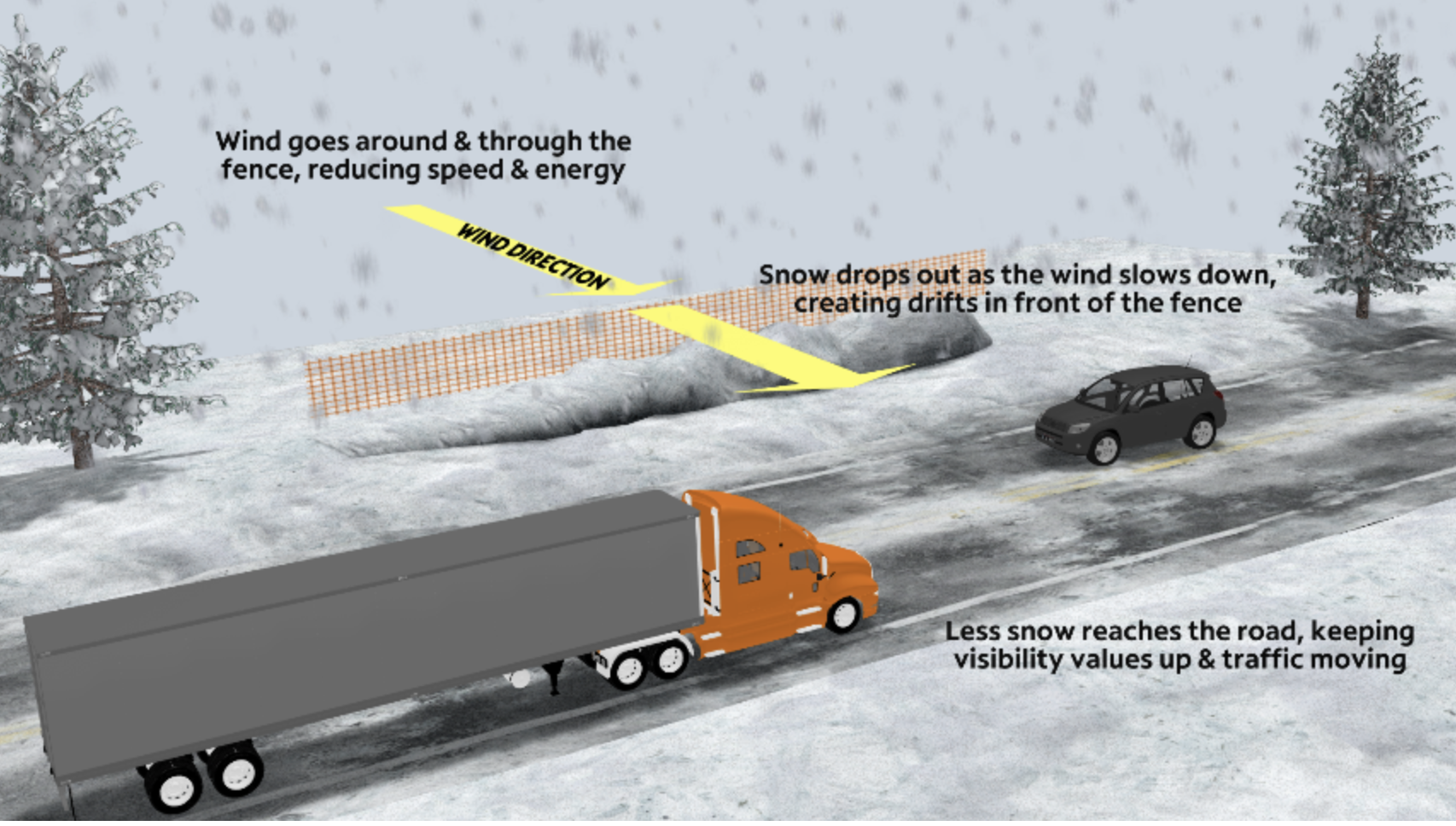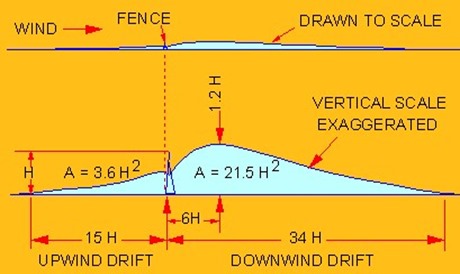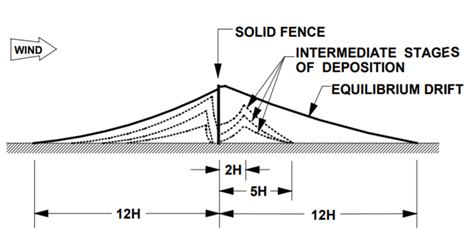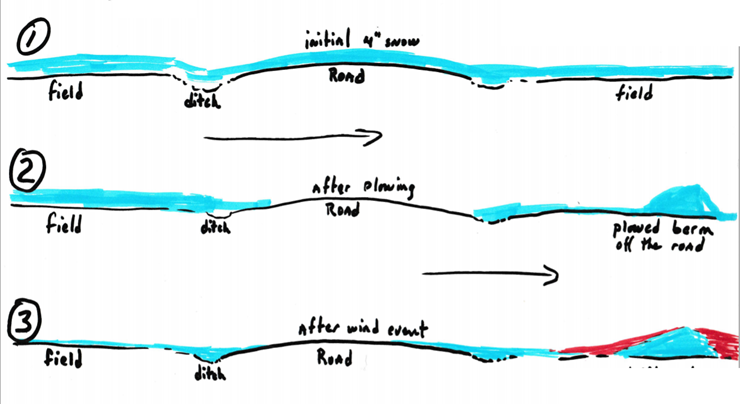How Snow Drifting Works - A Primer

Snow drifting is a major concern at the Bar D Ranch, and we fight with it every year. This post will discuss some of the science around snow drifting, how to minimize drifting, and our plans this year to try to minimize future problems in coming years.
We are lucky in that we have some residents that have lived on the Bar D Ranch for 20+ years, and they understand the drifting issues. However, most of them are incredibly frustrated because nobody will listen to them and learn how snow drifting works, based on our prevailing winds. This post, will, hopefully, make it a bit clearer to everyone that owns property at the Bar D Ranch.
The Science
Let’s start with the basic science.
Wind has a load capacity of what it can carry when it comes to snow. The higher the wind speed, the greater its carrying capacity.
In an ideal situation, with all land being flat, the wind will pick up snow and carry it along without dropping any more than it would pick up along the way. However, we do not have an ideal situation at the Bar D Ranch.
When wind, with its snow load, encounters an obstacle, it experiences turbulence. The loaded wind faces a compression zone (the area upwind of the obstacle) and a decompression zone (the area downwind of the obstacle). In both cases, the wind is disrupted, loses some speed, and drops some of its load.
 If you think of a snow fence as an obstacle, you can see that, depending on its height, snow will drop on the upwind side, but the vast majority of it will drop on the downwind side.
If you think of a snow fence as an obstacle, you can see that, depending on its height, snow will drop on the upwind side, but the vast majority of it will drop on the downwind side.
In the drawing, at the right, if the snow fence is 4’ high, then you can expect some snow to drop on the upwind side, up to 60’ before the fence, and you can expect most of the disrupted snow to fall on the downwind side, up to 136’ after the fence. These numbers are based on the snow fence having 50% porosity to allow the wind to pass through and disrupting it just enough to cause the vast majority of its load to drop on the downwind side.
A solid fence, or a wall of some kind, for example, will have a different result. Using the  same height, you could expect drifting out to 48’ on both the upwind and downwind side.
same height, you could expect drifting out to 48’ on both the upwind and downwind side.
Clearly, walls are not as good at controlling where the snow drops, as the wind is disrupted.
Takeaway
Snow drifts can be managed, to a large extent, by placing snow fencing well upwind of a road, say about 140-150’, so that the wind is able to drop its load before the road. As an added benefit, the wind, stripped of its load, can pick up snow that might exist on the road.
All plowed snow should be put on the downwind side of the road, off of the road a good bit, as that snow that is left as a berm acts like a wall.
Ideal Road Configuration and Plowing
What we would like to see for our roads and our plowing is a situation like this drawing provided by Jim Halpin.

In this drawing, the wind will blow the snow over the road. Once it is deep enough, which would be more than the 4” shown, the snow should be plowed so that the resulting berm is n the downwind side.
The berm, at this point, is similar to a wall, and the wind, with its load of snow, will drop some of it in the compression zone and some of it in the decompression zone.
The Problem We Face
When this year started, the grader was not available, and roads were cleared using the backhoe. Because of this, snow was not all moved downwind, and we ended up with berms on both sides of the road. Drawing, also provided by Jim Halpin.

Considering these berms as walls, that would mean if the berm is 12” high, then it will cause drifts of about 12’ out onto the road for the upwind berm, and the downwind berm will cause the same amount on its upwind side.
As the berms grew in size, on each side, the wind would drop its load on both sides of both berms, and we got drifts as illustrated in red in the above picture.
Two Solutions
The problem could have been corrected by either:
- Moving the snow away from the upwind berm so that it is on the downwind side.
- Moving the snow in the upwind berm way out into the fields on the upwind side so it acts as a solid wall and provides a 50/50 split on its upwind and downwind sides well away from the road.
New Problem – Mud
Well, it isn’t really a new problem, in that we see this every year, but the melting snow is now melting onto the roads and causing lots of mud. This is a significant issue on Clark, for example, where snow was placed upwind, and uphill. As the uphill berms melt, the water flows directly onto Clark.
This year, though, we have even more snow stacked up alongside all of the roads, and the amount of mud is worse than in the past, and it will not be alleviated until all of the snow is gone and the roads have a chance to dry out.
This Spring/Summer Plan
A large amount of snow fence, and fence posts will be ordered and placed in several locations to reduce drifting on our roads.
This serves a couple of purposes:
- Reducing the drifts on our roads, obviously
- Capturing the snow so it melts into our water basins
Sources
Basics of Blizzards and Snowdrift Control
Controlling Blowing and Drifting Snow
Optimization of Snow Drifting Mitigation and Control Methods